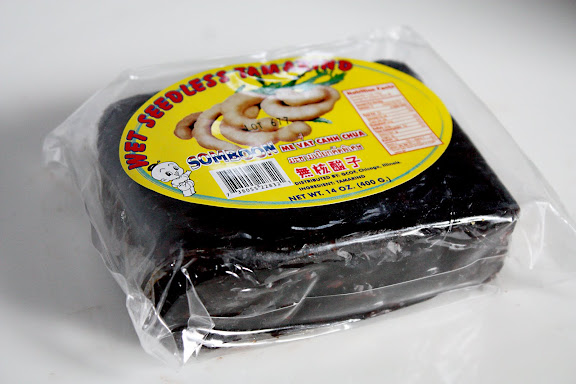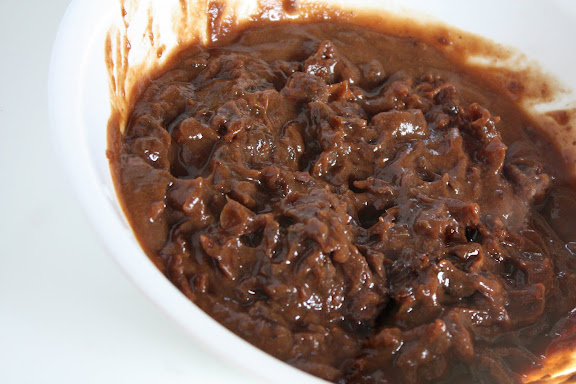
One major ingredient in the Thai cuisine is the pulp of dried mature tamarinds. It’s one of the most prominent souring agents right up there with lime juice. Knowing how to prepare tamarind pulp from dried tamarind pods is, therefore, very important if you’re one of those people who take Thai cooking seriously.
If you plan on making your own Pad Thai in the future, familiarity with how to prepare tamarind pulp will serve you well.
Now that I think about it, the reason I have not blogged about Pad Thai [Added 01-01-12: I have recently blogged about Pad Thai], perceived worldwide to be the quintessential Thai dish, is mainly because I want to introduce to you first each of what I consider to be the essential ingredients. Tamarind pulp, the ideal souring agent of the dish, is first on the list.

Too often, tamarind pulp is referred to as tamarind juice. The only explanation for this obvious misnomer that I can think of is that the Thais call prepared tamarind pulp, “น้ำมะขาม(เปียก),” which is literally “tamarind water.” Needless to say, น้ำมะขามเปียก is not at all the juice of the unjuiceable tamarinds; it is the hydrated and disintegrated pulp of this fruit-like legume.
This is similar to “prune juice” which is also a misnomer as you don’t “juice” the prunes to get prune juice; you take the pulverized pulp of dried plums and add enough water to it to make it drinkable. It is also the case with tamarind “juice.” If you go to Thailand and some countries in Latin America, you may see tamarind juice offered as a beverage. That beverage is nothing but water flavored with tamarind pulp. And the tamarind pulp which we’re talking about here is simply a much, much more concentrated version of what is referred to as tamarind juice.
Did I thoroughly confuse you yet?
I believe the juice vs. pulp issue is worth mentioning because most prepared tamarind pulp that you’ll see in Asian markets is labeled, “tamarind juice” or “tamarind juice concentrate.” When you see something like that, just know that it is, in fact, tamarind pulp.
Why make your own? Well, one reason is that it’s more economical that way. When you buy the watery prepared tamarind pulp that comes in a plastic tub, you get mostly water and frustratingly small amounts of tamarind for your money. When you buy a block of shelled tamarinds as shown here, you get 100% tamarinds and no filler.

This leads to the other reason why you should prepare your own tamarind pulp. As mentioned above, most brands of prepared tamarind pulp that I have seen on the market are too thin and watery. This means in order to get the desired level of sourness, you need to put in more of it.
The souring agent is the tamarind pulp proper; the water is merely the vehicle that is there only to help soften and loosen the pulp.
Therefore, to get maximum sourness without adding too much liquid to the dish, you need prepared tamarind pulp that contains as little water as possible. You’re not going to get that from commercial prepared “tamarind juice concentrate.”
Does the level of concentration make a difference? In some dishes, this is not a battle worth dying in. In other dishes, however, too much liquid produces less-than-desirable results. Take Pad Thai for example. Adding too much liquid could very well result in the noodles being tragically soggy and falling apart. You definitely don’t want that.
In the US, dried tamarinds are often sold whole at Hispanic markets or in blocks (with the shells, or sometimes both the shells and seeds, removed) at Asian markets. I like the block kind as it eliminates one messy step.
The ratio of tamarind pulp and water that works best for me is one ounce of shelled tamarinds per one fluid ounce of water. This results in prepared tamarind pulp that is thick in consistency and concentrated in flavor. The amount of water is just enough to allow the shelled tamarinds to soften up and disintegrate without much manual labor on your part. Other than that, the water serves no purpose whatsoever.
For a 14-ounce block of tamarinds shown here, I use 14 fluid ounces of lukewarm water (1 3/4 cups). [Block tamarinds are the easiest to work with. Having been shelled, deseeded, and kept in a condition wherein they stay moist, block tamarinds don’t need to be boiled or soaked in boiling water.] I let it soak for 15-20 minutes. Then I grab a handful of the tamarind pods and keep squashing and squeezing the now-softened pulp to separate it from the veins, the seeds, and the tough membranes that cover the seeds. Use both hands for extra pleasure.
What you end up with after the squashing and squeezing is a thick purée of tamarind pulp along with the veins, seeds, and membranes. Some people run the tamarind pulp purée through a sieve to separate out the pulp. When you deal with large amounts of tamarind purée, this makes more sense. However, I prefer to grab a handful of the tamarind purée and squeeze it really hard. The tamarind pulp purée will seep through your fingers as you tighten your fist while the veins, seeds, and membranes stay inside. Then you keep the purée and throw away the junk in your fist.* You keep doing this until you end up with nothing but thick and smooth tamarind pulp in the bowl.

It may sound like a messy, icky undertaking, but in less than half a minute into it, if that long, you will have this very strangely pleasant why-didn’t-I-do-this-before feeling. Trust me. I’ve done this for years and every time still feels like the first time.
This ratio of 14 ounces tamarinds and 14 fluid ounces of water will yield approximately 16 fluid ounces (2 cups) of very concentrated tamarind pulp, ready to use in any recipe. All recipes calling for prepared tamarind pulp, which you will find here henceforth, assume that the pulp is prepared in this manner and has this consistency.
If you plan to use a lot of prepared tamarind pulp in a week or two, you can store it in a glass jar in the refrigerator. For longer storage, I recommend that you freeze it as prepared tamarind pulp can get moldy after a couple of weeks in the refrigerator. If you have ice trays, fill them with the tamarind pulp, freeze, pop out the frozen cubes and store them in a freezer bag in the freezer. That way you can thaw out just a few cubes when you only need a small amount.
Angry Asian Creations makes a Khmer spicy beef and aubergine soup, “Samlaw Machou Kroeung,” with prepared tamarind pulp.
The Well-Seasoned Cook makes Indian Spiced Tamarind Cooler with tamarind pulp
*My maternal grandmother never threw away the leftover tamarind veins and membranes. She used them as a facial scrub. She also sometimes used the pulp as a facial mask. It must have worked as my grandma was one really hot woman and remained so well into her 70s (needless to say I didn’t inherit those genes …). I once witnessed how her doctor, who was in his mid-40s back then, hit on my grandma who was probably 75 at that time. It was quite entertaining.







79 Responses to How to Prepare Tamarind Pulp (น้ำมะขามเปียก) for Thai Cooking